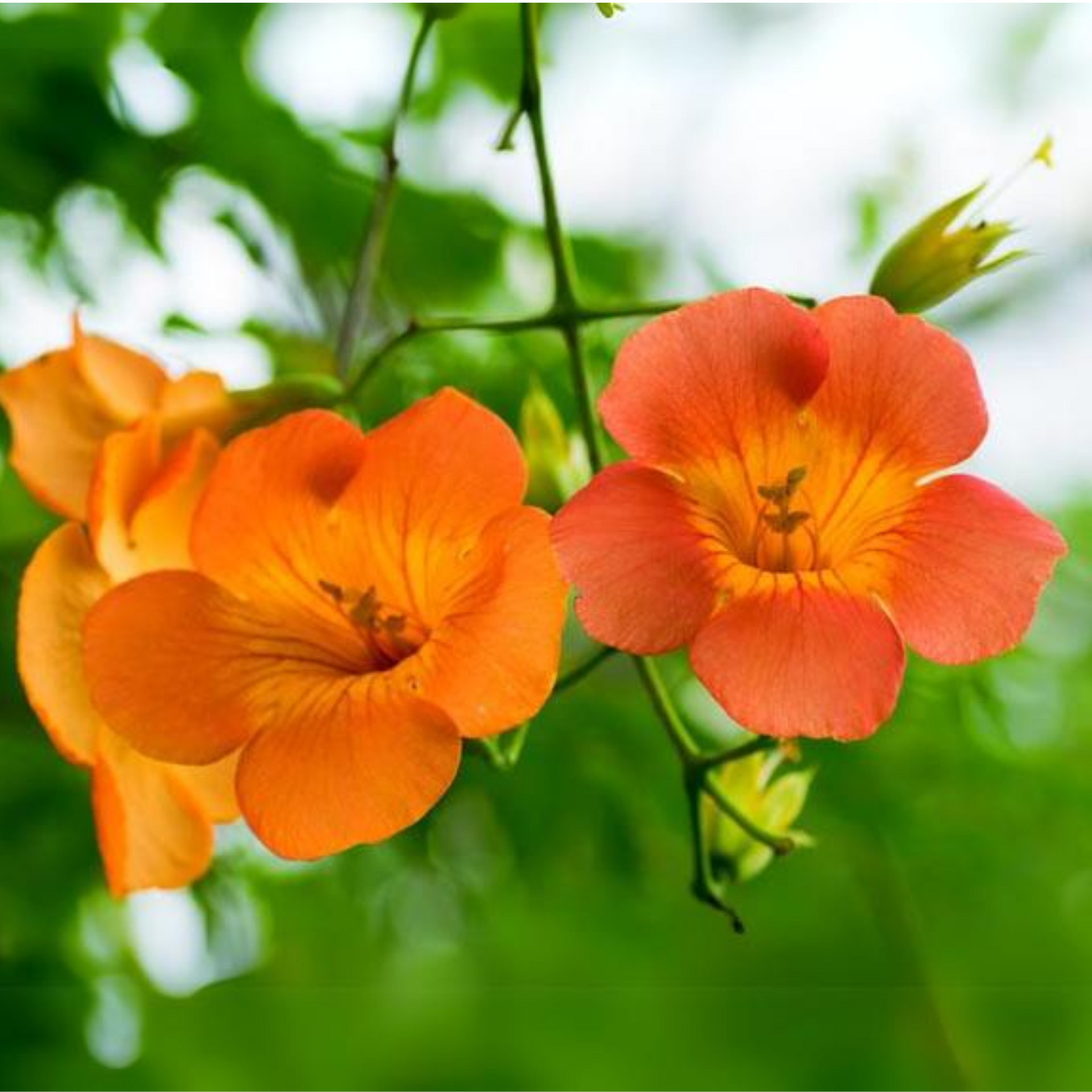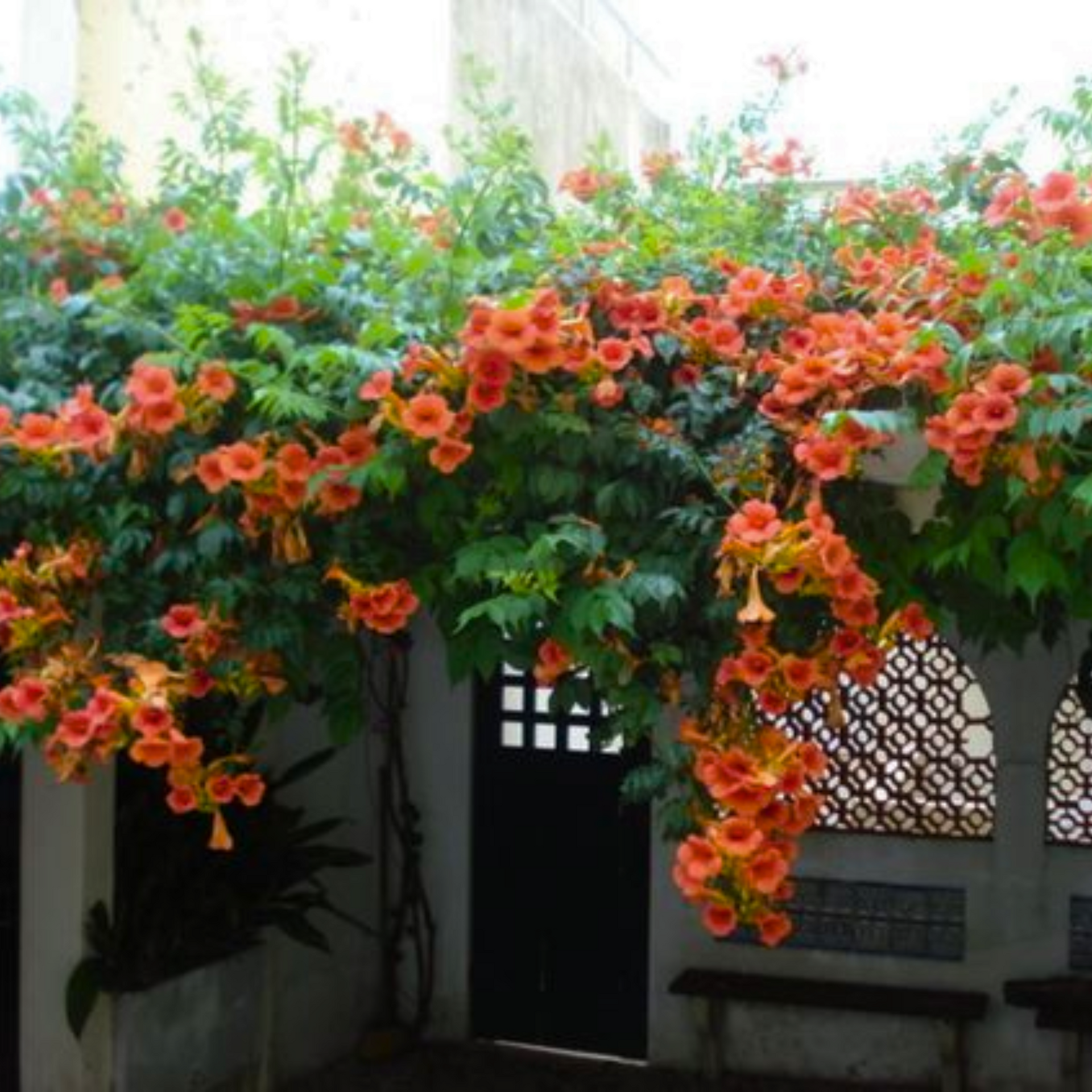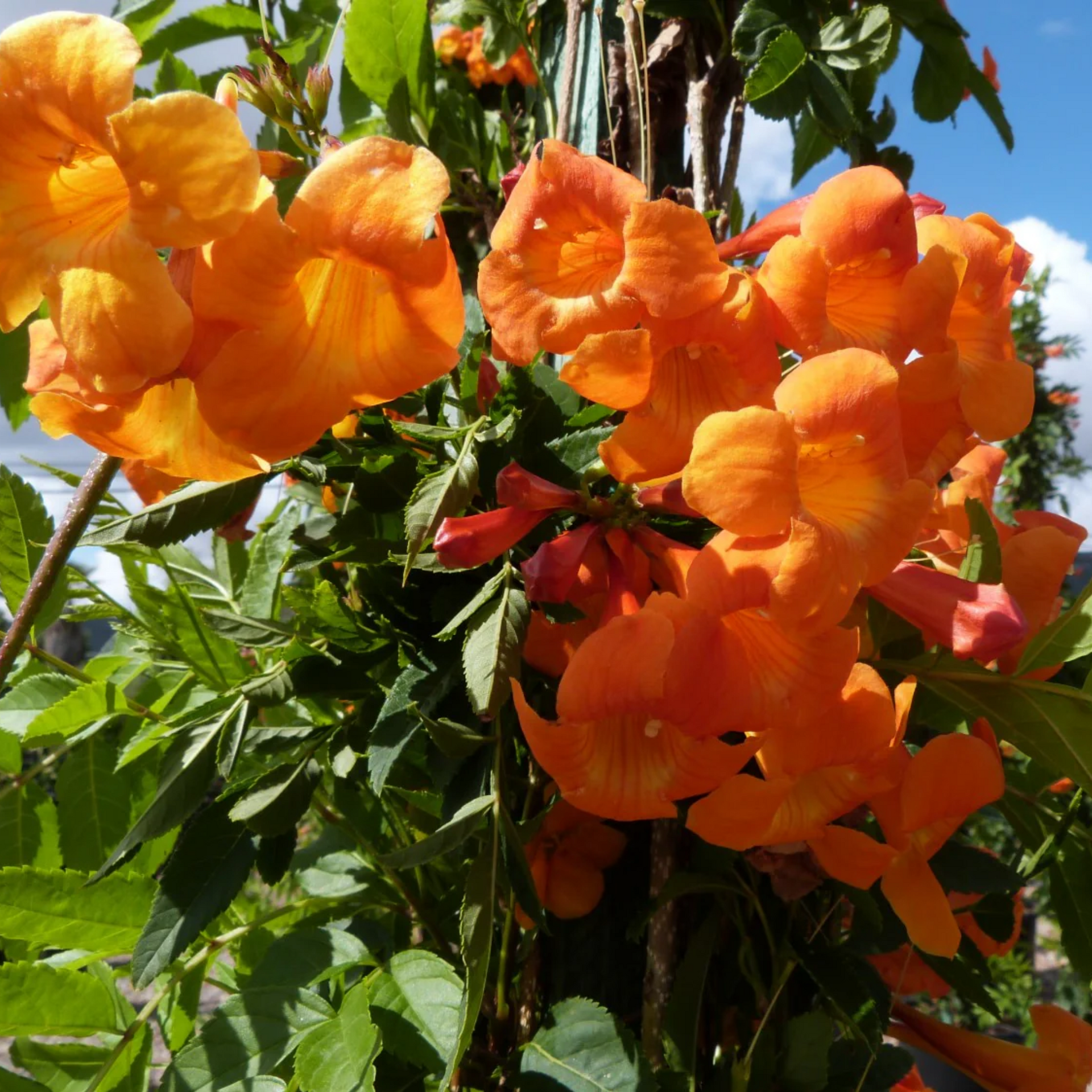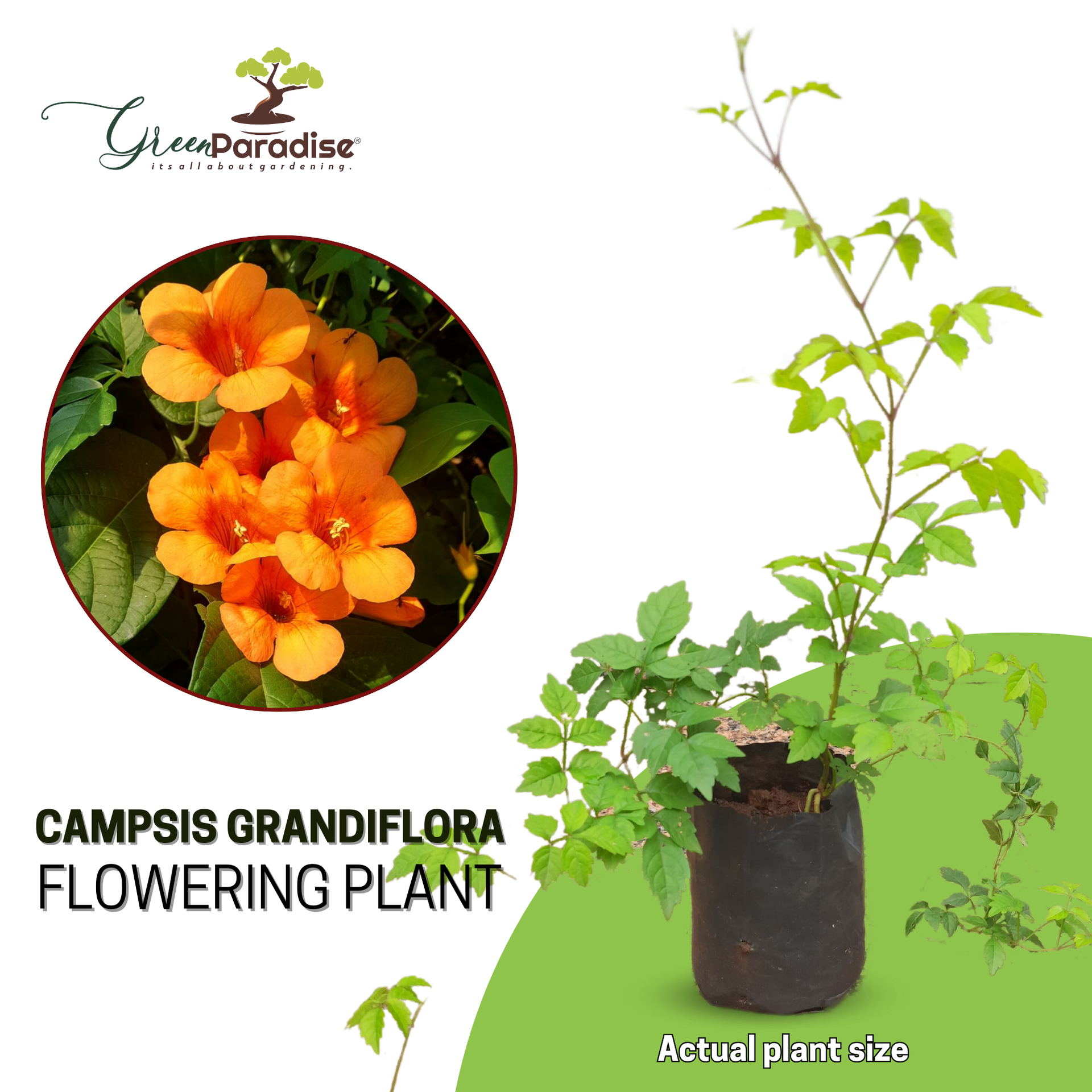



Campsis grandiflora Chinese Trumpet Creeper Orange Live Plant
Guaranteed Safe Checkout
Green Paradise Offers Beautiful Campsis
Grandiflora Chinese Trumpet Creeper
Orange Plant
About Campsis grandiflora Plant
Campsis grandiflora, commonly known as Chinese Trumpet Creeper or Chinese Trumpet Vine, is a flowering woody vine belonging to the Bignoniaceae family. It is native to China but is also cultivated in many other parts of the world as an ornamental plant due to its striking appearance and vibrant flowers.
Key characteristics of Campsis grandiflora:
Vine Structure:
- Chinese Trumpet Creeper is a vigorous and fast-growing deciduous vine that can reach heights of 30 to 40 feet (9 to 12 meters).
- It has strong, twining stems that allow it to climb and adhere to various surfaces, such as trellises, walls, and fences.
Leaves:
- The plant's compound leaves are pinnately divided and can be quite large, usually consisting of 7 to 11 leaflets.
- The leaves are glossy green and add to the overall attractiveness of the vine.
Flowers:
- One of the most distinctive features of Campsis grandiflora is its stunning trumpet-shaped flowers.
- These large, showy flowers are about 3 to 4 inches (7 to 10 cm) in length and have a bright orange hue, though some cultivars may display shades of red or yellow.
- The flowers typically bloom during the summer months, attracting pollinators such as bees and hummingbirds.
Fruit:
- After the flowers fade, Campsis grandiflora produces long, bean-like pods that contain numerous flat seeds.
- While these seed pods add some visual interest to the plant, they can also be a bit messy if left to drop to the ground.
Hardiness:
- Chinese Trumpet Creeper is considered a hardy plant and can thrive in a wide range of climates.
- It works nicely in USDA hardiness zones 5 through 9.
Cultivation:
- This vine prefers full sun to partial shade and can tolerate a variety of soil types as long as they are well-draining.
- Once established, it can be relatively drought-tolerant.
- However, it's essential to provide some support for the vine to climb, as it does not have aerial roots like some other climbing plants.
Care:
- Campsis grandiflora requires regular pruning to keep it in check as it can become quite invasive if left uncontrolled.
- The best time to prune is during the dormant season.
- Additionally, it's a good idea to watch out for potential pest problems, though the plant is generally quite resistant.
Caution:
- While the Chinese Trumpet Creeper can be a beautiful addition to the garden, it should be noted that it has the potential to become invasive, particularly in warmer climates.
- The aggressive growth and self-seeding nature of the plant can cause it to spread rapidly and compete with native vegetation.
- To prevent this, it's best to grow it in a controlled environment and remove any seedlings that may appear in unwanted areas.
Overall, Campsis grandiflora is a visually stunning vine that can add a burst of color and life to your garden. With proper care and management, it can be a captivating and rewarding plant to grow.
How To Grow Campsis Grandiflora Plant
Campsis grandiflora, commonly known as Chinese Trumpet Creeper or Chinese Trumpet Vine, is a beautiful climbing plant that produces stunning orange flowers.
Here's a guide on how to grow and care for Campsis grandiflora:
Climate and Location:
- Campsis grandiflora thrives in warm and sunny climates.
- It can take a little mild shade but loves full sun exposure.
- It is important to provide a sturdy support structure such as a trellis, pergola, or fence for the vine to climb on.
Soil:
- The Plant prefers well-draining soil that's rich in organic matter.
- It can tolerate various soil types, but it should not be waterlogged.
Planting:
- Plant the Campsis grandiflora in the spring or early summer when the soil has warmed up.
- Dig a hole that is twice the size of the plant's root ball and mix some compost or well-rotted manure into the soil.
- Place the plant in the hole and fill it with soil, then water thoroughly.
Watering:
- While the plant is establishing itself, it will need regular watering.
- Maintain consistent but not excessive moisture in the soil.
- Once the plant is established, it is moderately drought-tolerant and will require less frequent watering.
- However, during prolonged dry periods, water the plant to keep it healthy.
Mulching:
- Applying a layer of organic mulch around the base of the plant can help retain moisture, suppress weeds, and improve the soil over time.
Fertilizing:
- Campsis Grandiflora generally doesn't require a lot of fertilizer.
- You can apply a balanced, slow-release toxin in the spring to promote healthy growth and flowering.
Pruning:
- Prune the plant in late winter or early spring before new growth starts.
- Remove any dead or damaged wood and cut back the side shoots to a couple of buds from the main stem.
- Pruning will help control the size and shape of the plant and encourage better flowering.
Pests and Diseases:
- Chinese Trumpet Creeper is relatively resistant to pests and diseases, but keep an eye out for common garden pests like aphids and scale insects.
- If necessary, treat pest infestations with organic insecticides or by spraying the plant with a strong jet of water to dislodge the pests.
Propagation:
- You can propagate Campsis grandiflora through softwood or semi-hardwood cuttings in the summer.
- Take a cutting that is about 6 inches long, remove the lower leaves, dip the cut end in rooting hormone, and plant it in a pot with a well-draining potting mix.
- Keep the cutting moist and in a warm, sheltered location until roots develop.
By following these tips, you can successfully grow and enjoy the beautiful flowers of Campsis grandiflora. Just keep in mind that it is a vigorous climber, so provide enough space for it to grow and avoid planting it near structures where it could cause damage.






